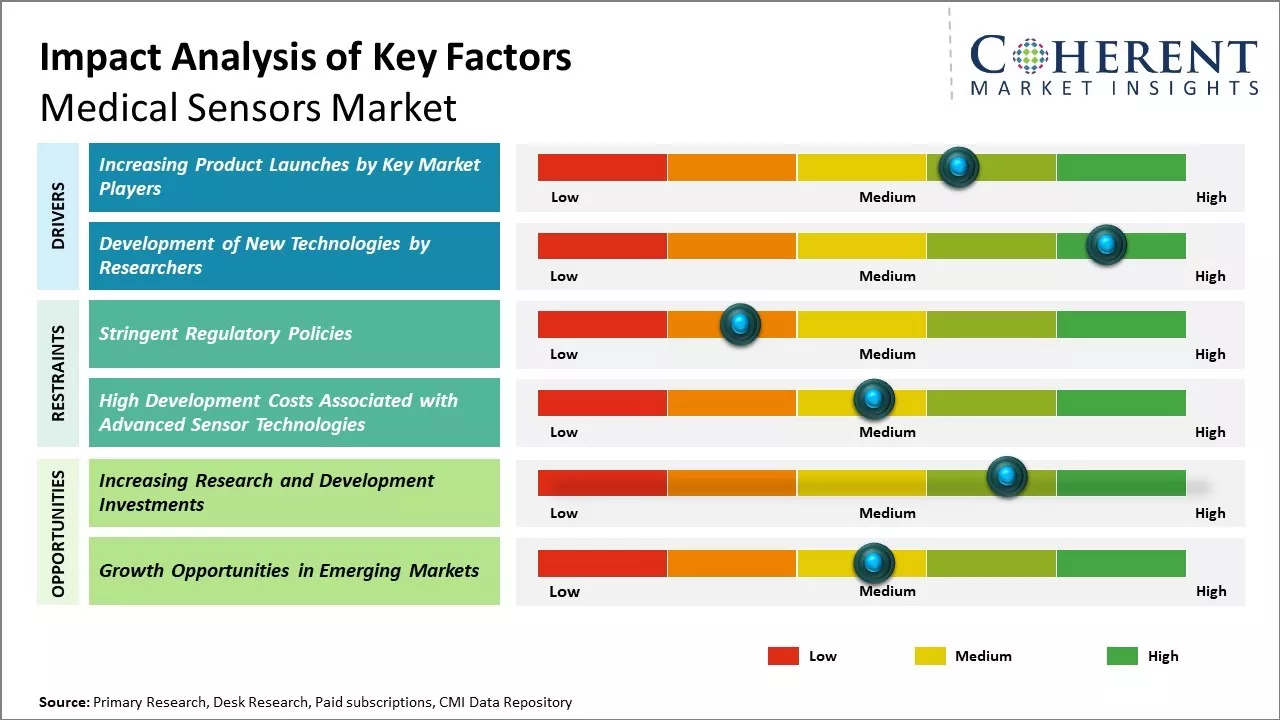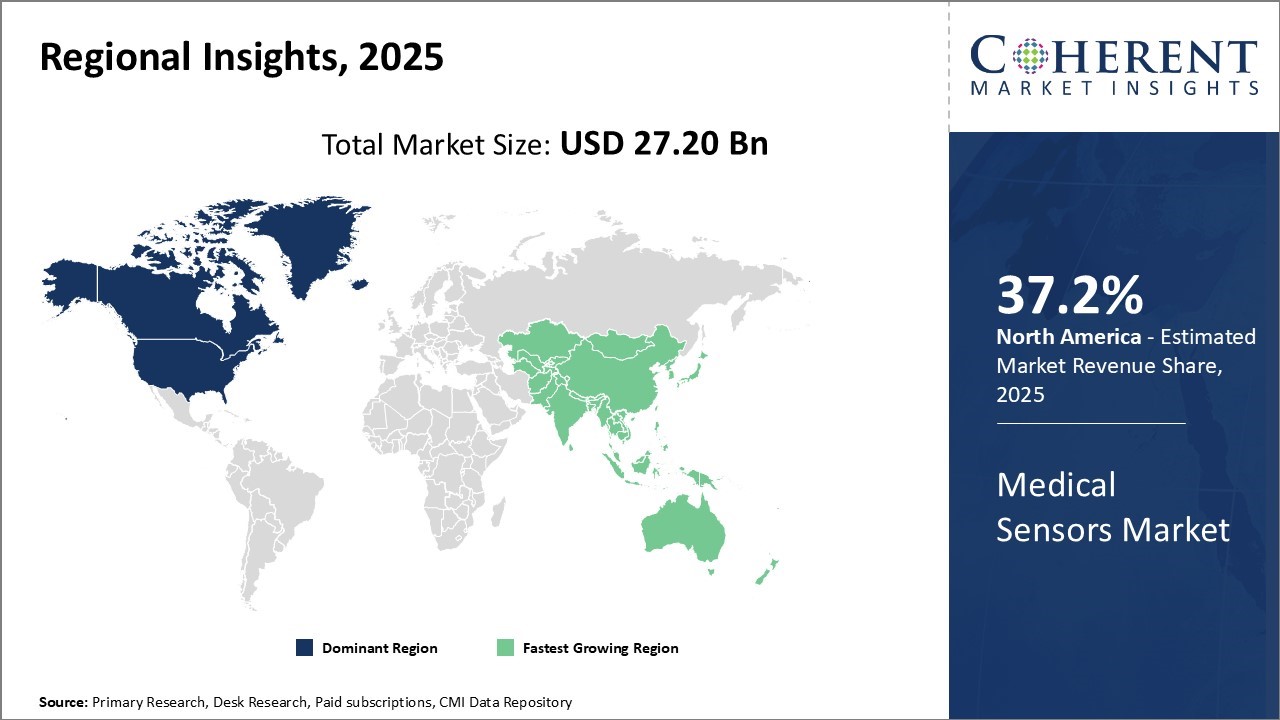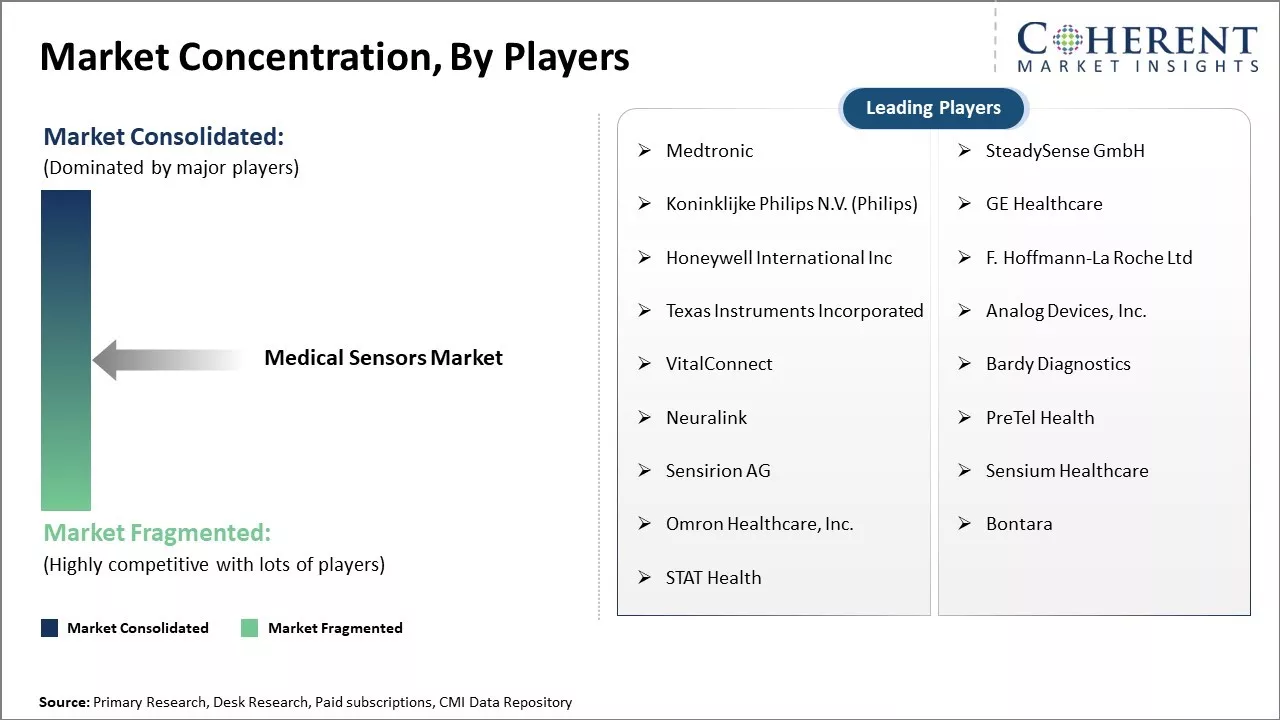The global medical sensors market is estimated to be valued at USD 27.20 Bn in 2025 and is expected to reach USD 55.10 Bn by 2032, exhibiting a compound annual growth rate (CAGR) of 10.6% from 2025 to 2032.

To learn more about this report, Download Free Sample
The medical sensors market is witnessing notable technological advancements like the miniaturization of sensors and the integration of the Internet of Things (IoT) and Artificial Intelligence (AI) into medical devices. This is allowing for the development of advanced wearable and remote patient monitoring solutions. Furthermore, the increasing investments by key players to develop cutting-edge sensors and rising focus on personalized healthcare are expected to open up new avenues for market players over the coming years.
|
Current Events |
Description and its impact |
|
Technological Investments & Innovations |
|
|
Regional Industrial Policies |
|
|
Regulatory Shifts in Key Markets |
|
|
Supply Chain Disruptions & Resource Shortages |
|
Uncover macros and micros vetted on 75+ parameters: Get instant access to report
Artificial Intelligence (AI) is playing a transformative role in the medical sensors market by enabling real-time data analysis, predictive insights, and personalized healthcare solutions. AI-enhanced sensors are now capable of detecting and interpreting complex physiological signals such as heart rate variability, respiration patterns, and bio-markers, helping to monitor chronic conditions, detect early signs of illness, and guide preventative care. The integration of AI with wearable and implantable medical devices also improves diagnostic accuracy and enables remote patient monitoring, reducing the burden on healthcare systems.
A recent example is PieX AI’s newly launched pendant, which uses on-device AI to manage mental health through advanced sensing technology. This wearable monitors emotional well-being by analyzing physiological cues and voice patterns to deliver real-time feedback and personalized support—all processed locally for enhanced privacy.
Based on the product type the market is bifurcated into temperature sensor, ECG sensor, blood glucose sensor, biosensor, motion sensor, and others (pressure sensors, etc.). The ECG sensor sub-segment is estimated to hold 33.3% of the market share in 2025, owing to the growing prevalence of cardiac diseases and the need for continuous monitoring of heart conditions. ECG sensors provide real-time analysis of the heart's electrical activity and identify any abnormalities or irregularities. They have become invaluable for diagnosing heart ailments and risks. The aging population profile in many countries has contributed to higher risks of heart attacks and strokes, driving more screening and monitoring needs globally.
Furthermore, technological advancements have made ECG sensors compact, wireless-enabled, and easy to use outside hospitals. This has supported their adoption not just in clinical settings but also in home care applications. More insurers are also providing coverage for ECG monitors to aid early detection. The ability of ECG sensors to detect subtle changes in heart rhythms well in advance makes them critical for managing high-risk cardiac patients, as well as emergencies. For instance, SCHILLER launched medilogFD, a new 12-lead Holter ECG device designed for comprehensive heart health analysis, including instant detection of atrial fibrillation and an optional SpO2 sensor for respiratory information. This is further accelerating the medical sensors market growth.
Based on the Mode of Delivery, the wearable segment dominates the market due to the rise in the Chronic disease burden & aging population, as the rising prevalence of chronic diseases such as diabetes, cardiovascular conditions, and COPD increases demand for continuous health monitoring through wearables, and it also helps in the consumer health awareness and fitness as increased public focus on preventive health and fitness drives adoption of smartwatches and health bands with medical-grade sensors.
For instance, the Huawei Watch 5 Pro announced to launch with an advanced ECG sensor and new health features, potentially including improved monitoring capabilities.
The application segment includes remote patient monitoring, fitness monitoring, chronic disease management, drug delivery, and others. The remote patient monitoring sub-segment is estimated to hold 42.2% of the market share in 2025 due to the growing need for managing chronic illnesses and the benefits it provides to patients, care providers, and payers. Remote monitoring devices equipped with various vital sign sensors allow the continuous tracking of patients outside hospitals and clinics. This helps improve engagement and adherence to treatment protocols. It also enables quick physician interventions if any abnormality is detected, thereby avoiding expensive emergency room visits or hospital readmissions. For payers and providers, remote monitoring lowers costs while allowing more people to be monitored simultaneously. It is particularly useful for aging populations with multiple comorbidities or who live in remote areas with limited access to care facilities.
Technological developments facilitating wireless transmission of clinical data have boosted remote monitoring adoption across therapeutic areas like diabetes, cardiovascular disorders, and respiratory illnesses, which require long-term follow-ups. In April 2025, Vivalink teamed up with Amazon Web Services (AWS) to introduce the Vivalink Biometrics Data Platform (VBDP), a cutting-edge solution for continuous remote patient monitoring. This partnership integrates Vivalink’s medical-grade sensors and edge computing capabilities with AWS’s powerful cloud infrastructure, enabling healthcare providers to access patient biometric data in real time and at scale.
The end user segment includes hospitals & clinics, home healthcare, fitness, and wellness centers. The hospitals & clinics sub-segment is estimated to hold 33.2% of the market share in 2025, owing to their key role in both acute and chronic medical care. As primary points of diagnosis, treatment, and monitoring, hospitals utilize a wide range of clinical-grade sensors for various therapeutic functions. This includes sensor-enabled hospital beds, ventilators, infusion pumps, as well as diagnostic monitoring devices like ECG and blood glucose monitors.
Moreover, the growing shift towards value-based care is prompting hospitals to take on more management of chronic illnesses. This necessitates continuous tracking of patients even after discharge using remote monitoring devices and home healthcare services. Hospitals are also investing in integrated sensor platforms and connected health solutions to streamline clinical workflows, improve safety, and optimize resource utilization. Expanding healthcare infrastructure in developing nations will further increase hospital end-users of medical sensors in the coming years. In June 2025, NthJEN LLC launched its advanced multi-sensor smart bed for the healthcare sector. Designed to monitor immobility, alert clinicians to potential risks, and aid in injury prevention, the technology blends compassion with precision. Led by Gogumalla, the team is actively collaborating with physical therapists, home care providers, and hospitals to expand its reach. This is further adding the medical sensors market share.

To learn more about this report, Download Free Sample
North America remains the dominant region in the global medical sensors market and is estimated to hold 37.2% of the market share in 2025. With a strong presence of key industry players and major healthcare organizations in countries like the U.S. and Canada, North America accounts for over one-third of the total market share. The region is home to prominent medical device manufacturers who have played a pivotal role in the development of cutting-edge sensor technologies.
Moreover, rise in chronic diseases and increasing healthcare expenditure in North America have propelled the demand for various medical sensors such as temperature sensors, blood glucose sensors, ECG sensors, image sensors, and pressure sensors in the past decade. For instance, the American company Mayo Clinic launched Anumana and Lucem Health to leverage AI and patient data for early disease detection. Anumana focuses on developing digital sensor diagnostics using the Mayo Clinic’s medical data and Inferences’ AI.
Asia Pacific has emerged as the fastest-growing regional market, driven by economies like China, India, Japan, and South Korea. Rapid urbanization and growing medical tourism in Asia Pacific countries have augmented the need for high-quality healthcare infrastructure. This has given a significant boost to the sales and production of medical sensors in the region.
Favorable governmental policies promoting local manufacturing have attracted global medical device giants to set up manufacturing units in the Asia Pacific. This has made various medical sensors more affordable and accessible to a large patient base. Further, increasing export activities of medical devices from countries like China and India have strengthened the supplier network in the Asia Pacific region. For instance, in June 2025, researchers at BITS Pilani, Hyderabad, developed a low-cost electrochemical biosensor that detects glucose and lactate from sweat, urine, blood, or cell culture media in under five minutes. Priced at just INR 15, it enables real-time metabolic monitoring without invasive blood sampling.
The rise in the United States medical sensors market is driven by increasing adoption of remote patient monitoring and wearables health technologies, particularly for chronic disease management. The growing geriatric population and the push for personalized, real-time health data are accelerating sensor integration in healthcare workflows. For instance, the U.S. company BioIntelliSensse has launched an FDA-cleared SpO2 (blood oxygen saturation) sensor, further expanding the capabilities of wearable health monitoring devices. Additionally, government support for digital health infrastructure and favorable reimbursement for connected devices further fuel market expansion.
The rise in India’s medical sensors market is driven by the increasing burden of chronic diseases like diabetes and cardiovascular conditions, demanding continuous monitoring solutions. Government initiatives like Ayushman Bharat and the push for digital health records are accelerating adoption. Additionally, the growth of telemedicine and monitoring devices among the urban population is fueling demand. For instance, Ambrosia has launched India’s first 24/7 real-time continuous glucose monitoring (CGM) and stress monitoring services. This service aims to provide a comprehensive view of a person’s glucose levels and stress, potentially helping individuals manage their health more effectively.

To learn more about this report, Download Free Sample
| Report Coverage | Details | ||
|---|---|---|---|
| Base Year: | 2024 | Market Size in 2025: | USD 27.20 Bn |
| Historical Data for: | 2020 To 2024 | Forecast Period: | 2025 To 2032 |
| Forecast Period 2025 to 2032 CAGR: | 10.6% | 2032 Value Projection: | USD 55.10 Bn |
| Geographies covered: |
|
||
| Segments covered: |
|
||
| Companies covered: |
Medtronic, SteadySense GmbH, Koninklijke Philips N.V. (Philips), GE Healthcare, Honeywell International Inc, F. Hoffmann-La Roche Ltd, Texas Instruments Incorporated, Analog Devices, Inc., VitalConnect, Bardy Diagnostics, Neuralink, PreTel Health, Sensirion AG, Sensium Healthcare, Omron Healthcare, Inc., Bontara, and STAT Health |
||
| Growth Drivers: |
|
||
| Restraints & Challenges: |
|
||
Uncover macros and micros vetted on 75+ parameters: Get instant access to report
Development of new technologies by researchers is expected to drive the global medical sensors market during the forecast period. For instance, various researchers are focused on the development of new technologies, which is expected to drive the global medical sensors market over the forecast period. For instance, researchers at the University of Minnesota announced that they had developed a new technique that allows the 3D printing of hydrogel-based sensors directly onto organs such as the lungs.
Increasing adoption of inorganic growth strategies, such as investments, is expected to offer lucrative growth opportunities in the market for the development of advanced medical sensors. For instance, in August 2022, Sibel Health, a medical technology company, announced that it had raised USD 33 Mn in Series B funding. This new series B funding of USD 33 million will advance Sibel's ANNE, a monitoring system, which is approved by the U.S. Food and Drug Administration, and scale up advanced wearable sensors for remote patient monitoring and hospital care. Moreover, this funding will advance bio-integrated sensors and wireless data collection, which promotes better care to newborns and mothers in developing countries.
Interviews were conducted with clinical operations managers, regulatory affairs directors, business development heads, project managers, medical monitors, R&D directors, pharmacovigilance heads, supply chain leaders, and procurement managers involved in the development, clinical evaluation, site operations, and commercialization of composite-based medical devices and materials across orthopedics, dental, cardiovascular, neurological, and minimally invasive therapeutic domains.
Share
Share
About Author
Komal Dighe is a Management Consultant with over 8 years of experience in market research and consulting. She excels in managing and delivering high-quality insights and solutions in Health-tech Consulting reports. Her expertise encompasses conducting both primary and secondary research, effectively addressing client requirements, and excelling in market estimation and forecast. Her comprehensive approach ensures that clients receive thorough and accurate analyses, enabling them to make informed decisions and capitalize on market opportunities.
Missing comfort of reading report in your local language? Find your preferred language :
Transform your Strategy with Exclusive Trending Reports :
Frequently Asked Questions
Joining thousands of companies around the world committed to making the Excellent Business Solutions.
View All Our Clients